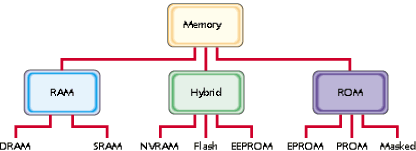DRAM (Dynamic Random Access Memory)
DRAM stands forDynamic Random Access Memory. It is used in most of the computers. It isthe least expensive kind of RAM. It requires an electric current to maintain its electrical state. The electrical charge of DRAM decreases with time that may result in loss of DATA. DRAM is recharged or refreshed again andagain to maintain its data. The processor cannot access the data of DRAM when it is being refreshed. That is why it is slow.
The capacitor can be either charged or discharged; these two states are taken to represent the two values of a bit, conventionally called 0 and 1. A DRAM storage cell is dynamic in that it needs to be refreshed or given a new electronic charge every few milliseconds to compensate for charge leaks from the capacitor.
SRAM (Static Random Access Memory)
SRAM stands for Static Random Access Memory. It can store data without any need of frequent recharging. CPU does not need to wait to access data from SRAM during processing. That is why it is faster than DRAM. It utilizes less power thanDRAM. SRAM is more expensive as compared to DRAM. It is normally used to builda very fast memory known as cache memory.
SDRAM
Synchronous dynamic random access memory (SDRAM) is dynamic random access memory (DRAM) that is synchronized with the system bus.a type of DRAM that can run at much higher clock speeds than conventional memory. SDRAM actually synchronizes itself with theCPU's bus and is capable of running at 133 MHz, about three times faster than conventional FPM RAM.
Double data rate type three SDRAM (DDR3 SDRAM) is a type of synchronous dynamic random-access memory (SDRAM) with a high bandwidth ("double data rate") interface.
The primary benefit of DDR3 SDRAM over its immediate predecessor, DDR2 SDRAM, is its ability to transfer data at twice the rate (eight times the speed of its internal memory arrays), enabling higher bandwidth or peak data rates.
Double data rate type three SDRAM (DDR3 SDRAM) is a type of synchronous dynamic random-access memory (SDRAM) with a high bandwidth ("double data rate") interface.
The primary benefit of DDR3 SDRAM over its immediate predecessor, DDR2 SDRAM, is its ability to transfer data at twice the rate (eight times the speed of its internal memory arrays), enabling higher bandwidth or peak data rates.
=================
Generally, SRAM is used only where access speed is extremely important. A lower cost-per-byte makes DRAM attractive whenever large amounts of RAM are required. Many embedded systems include both types: a small block of SRAM (a few kilobytes) .
RAM is volatile and ROM is Non-Volatile.

| Type | Volatile? | Writeable? | Cost (per Byte) | Speed |
| SRAM | Yes | Yes | Expensive | Fast |
| DRAM | Yes | Yes | Moderate | Moderate |
| Masked ROM | No | No | Inexpensive | Fast |
| PROM | No | Once, with a device programmer | Moderate | Fast |
| EPROM | No | Yes, with a device programmer | Moderate | Fast |
| EEPROM | No | Yes | Expensive | Fast to read, slow to erase/write |
| Flash | No | Yes | Moderate | Fast to read, slow to erase/write |
| NVRAM | No | Yes | Expensive (SRAM + battery) | Fast |
ROM stands for Read-only memory. It is a type of memory storage used in computers and other electronic devices.
Mask ROM – It is also known as MROM. It is a static ROM which comes programmed into an integrated circuit by its manufacturer. The software mask is burned into the chip and that is why it is termed as Mask ROM.
PROM –It stands for Programmable Read Only Memory. It was first developed in 70s by Texas Instruments. It is made as a blank memory. A PROM programmer or PROM burner is required in order to write data onto a PROM chip. The data stored in it cannot be modified and therefore it is also known as one time programmable device.
EPROM – It stands for Erasable Programmable ROM. It is different from PROM as unlike PROM the program can be written on it more than once. This comes as the solution to the problem faced by PROM.
EEPROM- It stands for Electrically Erasable Read Only Memory.These are also erasable like EPROM, but the same work of erasing is performed with electric current.
FLASH ROM– It is an updated version of EEPROM. In EEPROM, it is not possible to alter many memory locations at the same time. However, Flash memory provides this advantage over the EEPROM by enabling this feature of altering many locations simultaneously.
NVRAM (non-volatile RAM): is usually just an SRAM with a battery backup. When the power is turned on, the NVRAM operates just like any other SRAM. When the power is turned off, the NVRAM draws just enough power from the battery to retain its data. NVRAM is fairly common in embedded systems. However, it is expensive--even more expensive than SRAM, because of the battery
No comments:
Post a Comment